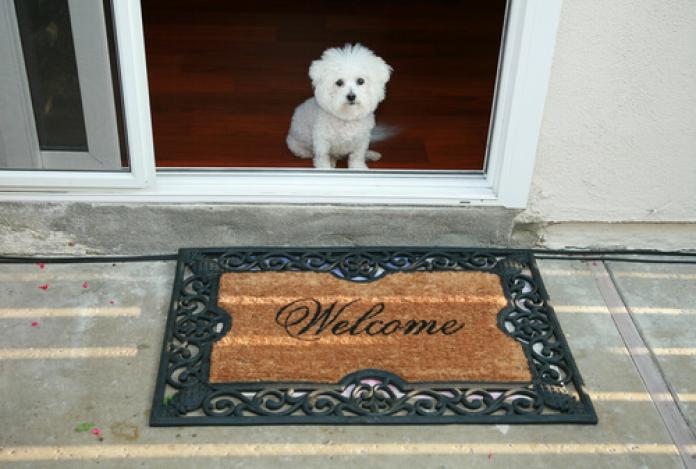How to Adopt a Dog From an Animal Shelter or Rescue Group
Get tips on how to find a good shelter or rescue group to help you adopt a great dog.

Kill Shelters Versus No-Kill Shelters
First, a word about “kill shelters” and “no-kill shelters.” Several million animals are euthanized in U.S. shelters every year. (1) That isn’t because the staff of so-called kill shelters are bloodthirsty maniacs. Some animals are desperately sick or badly injured. Some present behavior problems–more about that in a minute. And some die because the shelter is full and there aren’t enough adopters. The municipal shelters and animal control authorities that must take every animal brought to them–call them full-service shelters–don’t have the resources to keep animals indefinitely.
Life in a Shelter Is Lonely and Stressful for Dogs
Besides, life in a shelter, even a modern, well-funded shelter, is stressful and lonely. An animal may start out friendly and calm but grow behaviorally disturbed as time goes by, even to the point where keeping him or her alive stops being kind. Euthanasia rates have declined in recent decades, but they remain the downstream result of animal-related problems too big for a single shelter to resolve.
What Does “No-Kill” Mean?
“No-kill” isn’t a very good descriptor, either. Resources are always finite, so a shelter or rescue can’t be no-kill and accept every animal brought to it and provide adequate space and attention for all of them. A no-kill shelter has to limit the number of animals it takes in. Or it has to put an asterisk after “no-kill” with a footnote saying “except for sick animals and those with behavior problems.” Or it has to warehouse animals regardless of their mental health and whether it’s possible to give good care. Some animal hoarders may get started this way. A rescue group may reasonably decide it can help only x number of animals. But somebody, somewhere, has to deal with the rest.
How to Find Good Shelters and Rescue Groups
In short, you’re not looking for any particular label on the shelter or rescue. Instead, you want to see people doing their best to figure out which dogs can safely be adopted and which dogs and people will suit each other well. While the dog’s in their care, they’ll work to keep her behaviorally healthy and maybe teach her manners, to make her even more welcome in her future home.
What Are Dog Behavior Evaluations?
Shelters and rescues should use formal behavior evaluations (sometimes called “temperament tests”) to judge which dogs can’t safely be adopted. Most groups use one of several well-known procedures, or a variation on them. (2) Evaluators should be trained and the results of their assessments should periodically be compared against the results of other experienced evaluators. That helps prevent eccentric judgments.
How Dog Behavior Evaluations Work
Some aspects of an evaluation reflect normal human interaction with a dog. Others purposely try to push common dog buttons. For instance, an assessment might start with the evaluator just standing outside the dog’s kennel, looking at the dog. It’s worrisome if the dog reacts to such benign human behavior by throwing herself against the wire and snarling. Later steps involve various kinds of handling, such as wiping her paws and looking in her ears. How does she respond to a human who takes her by surprise? What happens if a human inflicts minor pain? Evaluators also try to learn whether the dog gets unmanageably excited or starts biting hard when people play with her.
Dog Evaluations Can Uncover Aggression
A biggie is the dog’s response to people touching him while he eats, sticking a (fake) hand in his food bowl, and trying to take away a supervaluable chew such as a pig ear. For me, this is often the heartbreaker. A dog may behave affectionately and sociably right up until that fake hand touches her bowl, and then–Cujo.
Many skeptics about behavior evaluation point out that shelter dogs are under stress and that former street dogs may have been chronically hungry for a time. The trouble is that any life includes stress. Sure, it’s possible that the dog who leaps at the fake hand and bites it five times wouldn’t so much as growl at a human messing with his food bowl if he were living in that human’s home. So why not place such a dog in an experienced home with no young children, and a rehabilitation plan? Because visitors happen, and kids running up to the dog on the street happen, and getting casual about prevention happens when weeks and months go by with no aggressive incidents. Also bear in mind the many dogs with no behavior problems, or only mild ones, still dying for lack of homes.
Dog Evaluations Aren’t Perfect
Of course, evaluations can’t guarantee that a dog won’t bite. One study found that they can miss territorial aggression, predatory aggression, and dog-dog aggression, in particular. (3) But in another study that compared assessment results with the dogs’ known histories, the two matched up pretty well. (4) The rate at which adopted dogs are returned for biting drops when evaluations are properly taught and used. (5) Using behavior as a yardstick beats making life-and-death decisions on the basis of how cute dogs are.
How Dog Shelters Match People and Dogs
So you’re at a shelter, or you’re looking at the website of a rescue, and they do careful behavior evaluations. Sorry! Still not done! Not every dog adoptable by someone is adoptable by you. A super-energetic adolescent, for instance, probably won’t suit a couple with two-year-old human twins. That family already has enough to keep it busy. On the other hand, if you have a blast teaching tricks, you might looooooove a quick, clever dog who would drive most normal people nuts.
Extra points, then, to shelters and rescue groups that steer dogs and people together by personality. Is this dog barky or quiet? Is he focused mainly on people or on other dogs or on that squirrel down the block? Is she cuddly? Does she live for fetch? Many shelters use the ASPCA’s “Meet Your Match” program, which puts each dog in one of three personality categories. A rescue group that cares for dogs in foster homes may be able to give all kinds of detail about your possible dog. Word to the wise, though: not everyone who fosters dogs has a sophisticated understanding of their behavior. Every so often I hear a fosterer say, for instance, that a dog is “alpha” when what she means is that he barks and lunges at other dogs. Go for those nuggets of actual observed behavior.
If you do decide to adopt, click here for my episode about bringing an adopted dog home.
Think carefully about what you want in a dog, then work with a shelter or rescue group that has everybody’s safety and happiness in mind. Next, give up your heart to your new best friend. Congratulations! I hope you and your dog will visit me on Facebook, follow me on Twitter, where I’m Dogalini, and write to me at dogtrainer@quickanddirtytips.comcreate new email. I welcome your comments and suggestions, and I answer as many questions as I can. Thank you for reading!
Notes
-
There are no reliable national statistics, only guesstimates. A study by the National Council on Pet Population Study and Policy covers the years 1994-1997 [sic] and, as the NCPPSP points out, has significant limitations. (That’s not to say anyone else could have done any better; there are huge difficulties in collecting such data.) As a sample, in 2007 New York City’s municipal shelter system euthanized 15,768 cats and dogs; this represents a decline of 54.53 percent over eight years.
The NCPPSP has prepared a brief paper highlighting reasons why animals are relinquished. Whether people’s stated reasons can be taken at face value is an open question: When people give up animals because they’re moving (the #1 reason for dogs, #3 for cats), is the bond already weakened by some other household problem, so that the move provides a pretext? And what constraints inflect the decision? I would never voluntarily move to a place where I couldn’t take my animals, but what would I do if I also had kids and the alternative was homelessness?
-
For example, this Canine Behavior Evaluationopens PDF file , based on a procedure developed by Sue Sternberg, and the SAFER “canine aggression assessment tool.”
-
Christensen, E’Lise, et al. 2007. Aggressive behavior in adopted dogs that passed a temperament test. Applied Animal Behaviour Science 106: 85-95.
-
Bollen, Kelley S., and Joseph Horowitz. 2008. Behavioral evaluation and demographic information in the assessment of aggressiveness in shelter dogs. Applied Animal Behaviour Science 112: 120-135.
-
Bollen, op. cit. See also Barbara Robinson, “Dog Is in the Details,” The Bark, spring 2004, available online here.
Image courtesy of Shutterstock


